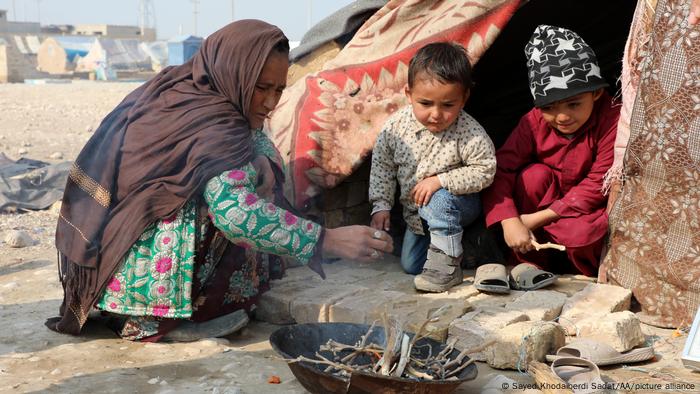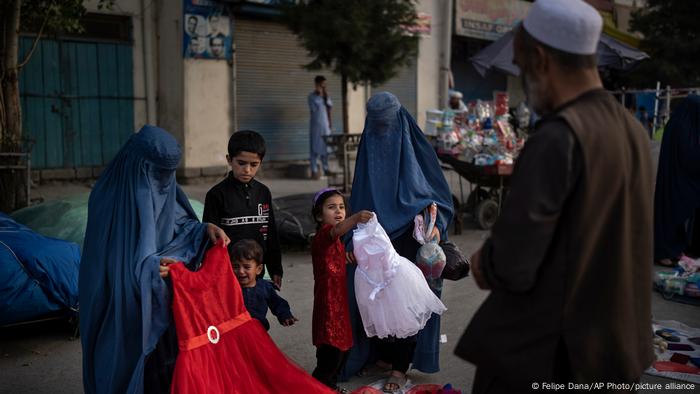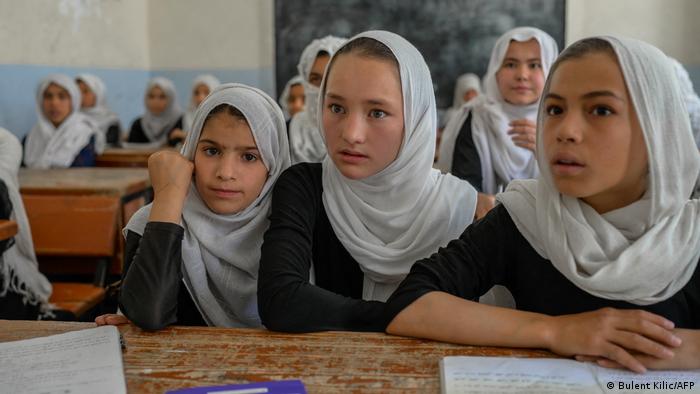

According to the UN, 87 percent of Afghan women have experienced some form of physical, sexual or psychological violence
(AFP/Elise BLANCHARD)
Elise BLANCHARD
Sat, January 1, 2022
Married off at seven to a man old enough to be her great-grandfather, Fatema endured rapes, beatings and starvation until she could take no more and tried to kill herself.
Through tears she recalls the beatings she received -- like the time, aged 10, she was flung against a wall and "my head crashed against a nail... I almost died".
Today the 22-year-old is living in one of the few shelters for battered women still open in Afghanistan since the Taliban's August return to power, but is fearful she could lose her place at any time.
If the refuge closes, Fatema will have nowhere to go. She has lost touch with her own family, while in-laws have vowed to kill her for dishonouring their name.
Fatema's plight is shared by millions in Afghanistan, where patriarchal tradition, poverty and a lack of education have held back women's rights for decades.
According to the United Nations, 87 percent of Afghan women have experienced some form of physical, sexual or psychological violence.
Despite this, the country of 38 million had only 24 shelters dedicated to their care before the Taliban's return -- almost all financed by the international community and frowned upon by many locals.
Elise BLANCHARD
Sat, January 1, 2022
Married off at seven to a man old enough to be her great-grandfather, Fatema endured rapes, beatings and starvation until she could take no more and tried to kill herself.
Through tears she recalls the beatings she received -- like the time, aged 10, she was flung against a wall and "my head crashed against a nail... I almost died".
Today the 22-year-old is living in one of the few shelters for battered women still open in Afghanistan since the Taliban's August return to power, but is fearful she could lose her place at any time.
If the refuge closes, Fatema will have nowhere to go. She has lost touch with her own family, while in-laws have vowed to kill her for dishonouring their name.
Fatema's plight is shared by millions in Afghanistan, where patriarchal tradition, poverty and a lack of education have held back women's rights for decades.
According to the United Nations, 87 percent of Afghan women have experienced some form of physical, sexual or psychological violence.
Despite this, the country of 38 million had only 24 shelters dedicated to their care before the Taliban's return -- almost all financed by the international community and frowned upon by many locals.

- 'Start from scratch' -
Some NGOs running shelters stepped up their work long before the Taliban takeover.
The director of one organisation told AFP she began moving women away from shelters in unstable provinces in advance of the US troop withdrawal.
Some were sent back to their blood relatives in the hope they would be offered protection from vengeful in-laws. Others were sent to shelters in bigger provincial capitals.
As the Taliban onslaught continued the situation became desperate, and around 100 women were transferred to Kabul -- only for the capital to fall.
"We have to start from scratch," says the director, who asked not to be named or the organisation identified while they navigated how to operate under the new regime.
The Taliban insist their strict interpretation of the Koran provides women with rights and protection, but the reality is very different and they are slowly being squeezed out of public life.
Most secondary schools for girls are shut, women are barred from government employment apart from select specialised areas, and this week new guidelines stated they cannot undertake long journeys unless accompanied by a male relative.
There has been some glimmer of light.
Earlier this month supreme leader Hibatullah Akhundzada denounced forced marriage, while Suhail Shaheen -- the Taliban's would-be ambassador to the UN -- told Amnesty International that women could go to court if they were victims of violence.
The regime has not made any formal pronouncement on the future of shelters, although the refuges have not escaped their notice.
Taliban fighters and officials have paid several visits to the one housing Fatema and around 20 other women, according to employees.
"They came in, looked at the rooms, checked there were no men," said one worker.
"They said this is not a safe place for women, that their place is at home," said another.
Still, it gave one woman hope.
"It was much better than we expected," the first worker told AFP.

- 'Accused of lying' -
Even before the Taliban takeover many women in abusive households had little recourse.
Zakia approached the Ministry of Women's Affairs -- since shut down by the Taliban -- for advice on how to escape a father-in-law who had threatened to kill her.
"They didn't even listen to me," she said, and told her that her situation was not that bad.
Mina, 17, who ran away from an abusive uncle seven years ago with her younger sister, had a similar reception.
"The ministry accused me of lying," she told AFP.
And it is not just the women seeking shelter who are vulnerable, with Amnesty International saying shelter workers also "risk violence and death".
Several staffers said they had been threatened over the phone by people claiming to be Taliban seeking the whereabouts of women who had fled their households.
Cases of abuse are likely to rise with the virtual collapse of the economy bringing soaring unemployment, a cash-flow crisis and mounting hunger.
"When the economic situation worsens, men are out of work, and cases of violence increase," one shelter worker said.
"The situation has probably worsened... services have generally decreased," said Alison Davidian, interim representative for UN Women in Afghanistan.
One of the few shelters open -- albeit discretely -- is run by Mahbouba Seraj, a pioneer in the struggle for women's rights in the country.
After being inspected by the Taliban it was "kind of left alone", she says, but her concern is now for the women trapped in abusive households who have nowhere to go.
Zakia, at least, has shelter for now -- but for how long?
"My own father said he didn't care about me," she says.
eb/tbm/ys/fox/axn
Taliban are revoking Afghan women's hard-won rights
Initial restrictions imposed by the Taliban after their takeover mostly targeted urban women. Now, the expanded rules could affect all women in Afghanistan.

Women have repeatedly protested for their rights since the Taliban came to power in August
Since the Taliban swept back to power in Afghanistan in August, they have been enforcing their fundamentalist interpretation of Islam. In spite of trying to rebrand as more moderate, the group has imposed a slew of restrictions that revoke the liberties that Afghan women have won through a history of struggle and activism, and unravel the gains made over the past two decades.
Following al-Qaeda's September 11, 2001, attacks in New York and Washington, DC, the United States invaded Afghanistan. The justifications for the war placed prominent attention on the Taliban's misogyny. According to the administration of then US President George W. Bush, the war on terror in Afghanistan was "also a fight for women's rights and dignity."
That drew attention to the plight of Afghan women, which translated to international aid and funding for social programs and NGOs focused on improving women's lives. This enabled women in urban areas, particularly in the capital, Kabul, to participate in public life in ways that were impossible under the Taliban regime.

Afghan women have sustained their families through war and poverty
But those changes failed to reach the countryside, where, according to data from the World Bank, about 70% of Afghans live. In the two-decade war, villages across Afghanistan have been scenes of countless clashes between Taliban-aligned groups and NATO and national forces. Rural women constantly suffered night raids, airstrikes and displacement, without getting the chance to benefit from the expanded opportunities for their counterparts in the cities.

Rural women lived through the war without benefiting from the programs that were introduced
A UN report published in July quotes rural women who say the 2020 withdrawal agreement between the United States and Taliban has meant less violence in their areas, greater freedom of movement and reduced anxiety.
The first restrictions that the Taliban introduced once they regained power mostly targeted urban and middle-class women. But they are expanding into a long list of rules, which will affect Afghanistan's entire female population.

LIFE IN AFGHANISTAN UNDER THE TALIBAN
New but old dress code
Although it is not yet mandatory for women to wear a burqa, many do so out of fear of reprisals. This Afghan woman is visiting a local market with her children. There is a large supply of second-hand clothes as many refugees have left their clothes behind.
123456789
Here are some of the restrictions that the Taliban have imposed on women so far:
TV and media
In November, the Taliban banned women from appearing on TV shows and in movies and ordered female journalists and presenters to wear headscarves.
According to a report released by Reporters Without Borders (RSF) in August, most female employees of media organizations stopped working after the Taliban takeover.
Women's Affairs Ministry abolished
Established in 2001, the Women's Affairs Ministry was abolished by the Taliban in September. Its office now houses the Propagation of Virtue and the Prevention of Vice Ministry.
Education cut off
The Taliban has effectively prohibited girls from receiving education higher than primary school by keeping most secondary schools for teenage girls closed, Human Rights Watch (HRW) reported in October.

According to the UN, girls represented some 40% of Afghan students before the Taliban takeover
According to World Bank data, the proportion of girls in primary schools in Afghanistan increased from less than 10% in 2003 to 33% in 2017, while their share in secondary schools was 39% in 2017, up from 6% in 2003.
Women banned from working
In early July, as the Taliban were seizing territory from government forces across Afghanistan, the group's fighters stormed into bank offices in the southern city of Kandahar and ordered women working there to leave.
After taking full control of Afghanistan, the group continued to eliminate women from workplaces. In September, one of the Taliban's senior figures told the Reuters news agency that Afghan women should not work alongside men. That statement was followed by another decree issued by the interim mayor ordering female employees of Kabul's city government to stay home.
Women accounted for 20% of the country's workforce in 2020, according to a report released by the UN Development Program in December, and a growing number of them ran small businesses.
Dress code, segregation
In September, the Taliban's education minister announced that gender segregation and Islamic dress code will be mandatory for universities.
All female students, teachers and staff must wear an Islamic abaya robe and niqab that covers the hair, body and most of the face, according to the regulations issued by the Education Ministry.
Afghan women have protested these restrictions multiple times, despite being assaulted with rifle butts, tear gas and metal clubs.
Edited by: Milan Gagnon
Initial restrictions imposed by the Taliban after their takeover mostly targeted urban women. Now, the expanded rules could affect all women in Afghanistan.

Women have repeatedly protested for their rights since the Taliban came to power in August
Since the Taliban swept back to power in Afghanistan in August, they have been enforcing their fundamentalist interpretation of Islam. In spite of trying to rebrand as more moderate, the group has imposed a slew of restrictions that revoke the liberties that Afghan women have won through a history of struggle and activism, and unravel the gains made over the past two decades.
Following al-Qaeda's September 11, 2001, attacks in New York and Washington, DC, the United States invaded Afghanistan. The justifications for the war placed prominent attention on the Taliban's misogyny. According to the administration of then US President George W. Bush, the war on terror in Afghanistan was "also a fight for women's rights and dignity."
That drew attention to the plight of Afghan women, which translated to international aid and funding for social programs and NGOs focused on improving women's lives. This enabled women in urban areas, particularly in the capital, Kabul, to participate in public life in ways that were impossible under the Taliban regime.

Afghan women have sustained their families through war and poverty
But those changes failed to reach the countryside, where, according to data from the World Bank, about 70% of Afghans live. In the two-decade war, villages across Afghanistan have been scenes of countless clashes between Taliban-aligned groups and NATO and national forces. Rural women constantly suffered night raids, airstrikes and displacement, without getting the chance to benefit from the expanded opportunities for their counterparts in the cities.

Rural women lived through the war without benefiting from the programs that were introduced
A UN report published in July quotes rural women who say the 2020 withdrawal agreement between the United States and Taliban has meant less violence in their areas, greater freedom of movement and reduced anxiety.
The first restrictions that the Taliban introduced once they regained power mostly targeted urban and middle-class women. But they are expanding into a long list of rules, which will affect Afghanistan's entire female population.

LIFE IN AFGHANISTAN UNDER THE TALIBAN
New but old dress code
Although it is not yet mandatory for women to wear a burqa, many do so out of fear of reprisals. This Afghan woman is visiting a local market with her children. There is a large supply of second-hand clothes as many refugees have left their clothes behind.
123456789
Here are some of the restrictions that the Taliban have imposed on women so far:
Long-distance travel
Afghan women have been banned from traveling more than 72 kilometers (45 miles) without a male relative since December 26. The Taliban Ministry for Propagation of Virtue and the Prevention of Vice made it illegal for drivers to give rides to women traveling alone. A senior member of Human Rights Watch told the AFP news agency that the decree prevents women from "being able to depart if they are facing domestic violence."
Afghan women have been banned from traveling more than 72 kilometers (45 miles) without a male relative since December 26. The Taliban Ministry for Propagation of Virtue and the Prevention of Vice made it illegal for drivers to give rides to women traveling alone. A senior member of Human Rights Watch told the AFP news agency that the decree prevents women from "being able to depart if they are facing domestic violence."
TV and media
In November, the Taliban banned women from appearing on TV shows and in movies and ordered female journalists and presenters to wear headscarves.
According to a report released by Reporters Without Borders (RSF) in August, most female employees of media organizations stopped working after the Taliban takeover.
Women's Affairs Ministry abolished
Established in 2001, the Women's Affairs Ministry was abolished by the Taliban in September. Its office now houses the Propagation of Virtue and the Prevention of Vice Ministry.
Education cut off
The Taliban has effectively prohibited girls from receiving education higher than primary school by keeping most secondary schools for teenage girls closed, Human Rights Watch (HRW) reported in October.

According to the UN, girls represented some 40% of Afghan students before the Taliban takeover
According to World Bank data, the proportion of girls in primary schools in Afghanistan increased from less than 10% in 2003 to 33% in 2017, while their share in secondary schools was 39% in 2017, up from 6% in 2003.
Women banned from working
In early July, as the Taliban were seizing territory from government forces across Afghanistan, the group's fighters stormed into bank offices in the southern city of Kandahar and ordered women working there to leave.
After taking full control of Afghanistan, the group continued to eliminate women from workplaces. In September, one of the Taliban's senior figures told the Reuters news agency that Afghan women should not work alongside men. That statement was followed by another decree issued by the interim mayor ordering female employees of Kabul's city government to stay home.
Women accounted for 20% of the country's workforce in 2020, according to a report released by the UN Development Program in December, and a growing number of them ran small businesses.
Dress code, segregation
In September, the Taliban's education minister announced that gender segregation and Islamic dress code will be mandatory for universities.
All female students, teachers and staff must wear an Islamic abaya robe and niqab that covers the hair, body and most of the face, according to the regulations issued by the Education Ministry.
Afghan women have protested these restrictions multiple times, despite being assaulted with rifle butts, tear gas and metal clubs.
Edited by: Milan Gagnon
No comments:
Post a Comment